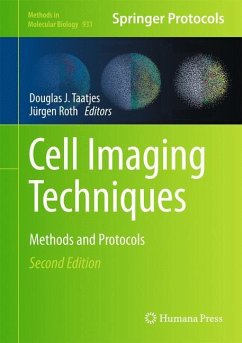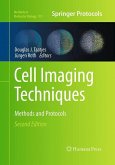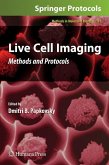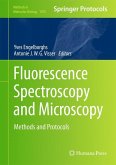Cell Imaging is rapidly evolving as new technologies and new imaging advances continue to be introduced. In the second edition of Cell Imaging Techniques: Methods and Protocols expands upon the previous editions with current techniques that includes confocal microscopy, transmission electron microscopy, atomic force microscopy, and laser microdissection. With new chapters covering colocalization analysis of fluorescent probes, correlative light and electron microscopy, environmental scanning electron microscopy, light sheet microscopy, intravital microscopy, high throughput microscopy, and stereological techniques. Written in the highly successful Methods in Molecular Biology(TM) series format, chapters include introductions to their respective topics, lists of the necessary materials and reagents, step-by-step, readily reproducible laboratory protocols, and tips on troubleshooting and avoiding known pitfalls
Authoritative and cutting-edge, Cell Imaging Techniques: Methods and Protocols, Second Edition is an easily accessible volume of protocols to be used with a variety of imaging-based equipment likely available in a core imaging facility.
Authoritative and cutting-edge, Cell Imaging Techniques: Methods and Protocols, Second Edition is an easily accessible volume of protocols to be used with a variety of imaging-based equipment likely available in a core imaging facility.
From the reviews of the second edition:
"The goal is to provide seasoned microscopists with a list of protocols to add sophistication to their existing microscopy regimen. The intended audience is experienced researchers who are familiar with imaging in a core microscopy facility. ... this book is more useful to microscopists who routinely use microscopic techniques in their research and are knowledgeable about the recent advances in technology. ... an ideal reference for a core microscope facility. Each chapter is written independently by a different group of researchers and can stand alone." -- Latha Malaiyandi, Doody's Book Reviews, December, 2013
"The goal is to provide seasoned microscopists with a list of protocols to add sophistication to their existing microscopy regimen. The intended audience is experienced researchers who are familiar with imaging in a core microscopy facility. ... this book is more useful to microscopists who routinely use microscopic techniques in their research and are knowledgeable about the recent advances in technology. ... an ideal reference for a core microscope facility. Each chapter is written independently by a different group of researchers and can stand alone." -- Latha Malaiyandi, Doody's Book Reviews, December, 2013
From the book reviews:
"The different techniques are described in deep details, the chapters having an abstract, introduction, materials, methods, and, last but not least, notes; each method is described step by step with very, very useful links to the notes. ... should be read not only by very specialized scientists, but also by those who usually work with classic microscopic methods, to open their minds and increase their appetite for more precise and complex measurements done on different level of complex biological structures." (Ioan I. Ardelean, Bulletin of Micro and Nanoelectrotechnologies, Vol. 5 (3-4), December, 2014)
"The goal is to provide seasoned microscopists with a list of protocols to add sophistication to their existing microscopy regimen. The intended audience is experienced researchers who are familiar with imaging in a core microscopy facility. ... this book is more useful to microscopists who routinely use microscopic techniques in their research and are knowledgeable about the recent advances in technology. ... an ideal reference for a core microscope facility. Each chapter is written independently by a different group of researchers and can stand alone." (Latha Malaiyandi, Doody's Book Reviews, December, 2013)
"The different techniques are described in deep details, the chapters having an abstract, introduction, materials, methods, and, last but not least, notes; each method is described step by step with very, very useful links to the notes. ... should be read not only by very specialized scientists, but also by those who usually work with classic microscopic methods, to open their minds and increase their appetite for more precise and complex measurements done on different level of complex biological structures." (Ioan I. Ardelean, Bulletin of Micro and Nanoelectrotechnologies, Vol. 5 (3-4), December, 2014)
"The goal is to provide seasoned microscopists with a list of protocols to add sophistication to their existing microscopy regimen. The intended audience is experienced researchers who are familiar with imaging in a core microscopy facility. ... this book is more useful to microscopists who routinely use microscopic techniques in their research and are knowledgeable about the recent advances in technology. ... an ideal reference for a core microscope facility. Each chapter is written independently by a different group of researchers and can stand alone." (Latha Malaiyandi, Doody's Book Reviews, December, 2013)








